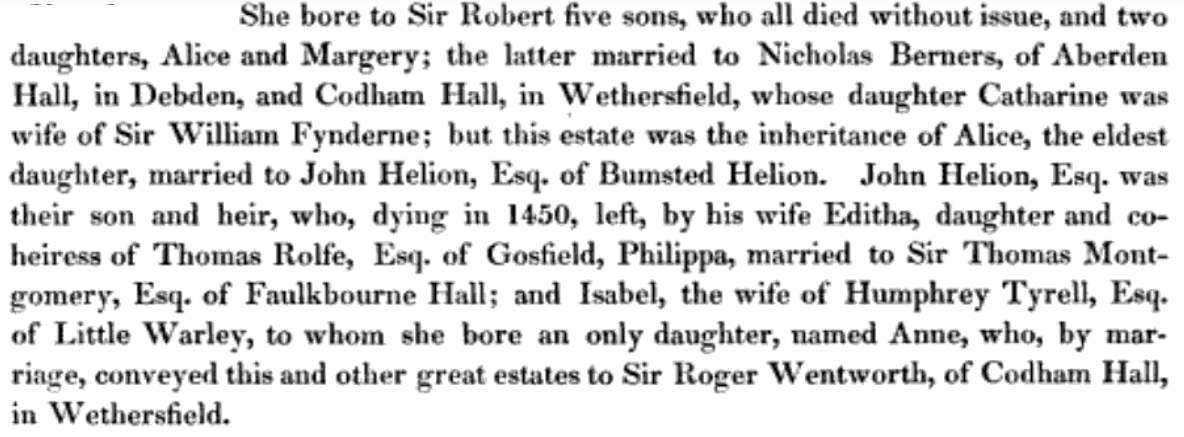Thomas Wright - The History and Topography of Essex
I have used Thomas Wright's account as a starting point for at least the Pre-Tudor History of Belchamp Walter. I have further extended my study of Thomas' work taking quotes from other sections of his book on Essex. The history and interconnection of families in the North Essex and Suffolk area are much explained in Thomas' work.

The manuscript was digitized by Google and is available for all to read on Google Play.
As I progress with my research I am finding that Thomas's text more and more difficult to interprete.
Thomas' text at first reading seems to over-simplify the situation. However, considering when it written and the resources that he had at the time, he did a pretty comprehensive job! He did use a variety of sources including Inquestions Post Mortem and Visitations from Hearalds.
An example relating to the families of Sir Robert Swynborne, Sir William Fyderne and John Helion
The original text:
I have yet to untangle the above. I had tried to re-write some of the text, but it still made little more sense.

Only when I have delved into other sources to confirm dates (where they exist) and names of parentage and offspring I have found that there are some discrepancies.
The date this was written
The book is dated 1831/36.
Queen Victoria started her reign in 1837 and the "Extensive renovations" to the church had not occured as this was 1859. These renovations were funded by John Mayne St.Clere R______ (d 1893).
It is my suspicion that the monument described by Thomas Wright was destroyed as a result of these renovations:
The BHO website listing, of an Inventory of Monuments in 1916 makes no mention of this monument. It does, however, make the comment that the chancel arch is "modern". This is kind ironic as in 2021 there is talk of removing the covering on this arch to reveal the Victorian wall paintings.
Interpretation of the text
Looking more closely it seems that I had not copied to footnotes from the original text. However, I am not sure if they actually provide much more information.
Below are a couple of examples. I will add them back to the relevant pages
Footnote on page 643/770 relating to the name de Beauchamp the demolition of Bedford castle and the Dictum of Kenelworth
Footnote on page 644/770 relating to John de Steyngreve and the death of John Botetourt.
What I think Thomas did - with respect to Essex village histories
Thomas Wright seems to have taken the visitations of heralds and transcribed them into prose.
An example of this is Robert Swynborne, where he says Sir Roberts daughter, Margery, was married to Nicholas Berners of Aberden Hall, in Debden (the heralds tree says Nicholas Barneys de Fynchingfield).
That being said, Thomas still does a pretty good job at quoting his sources and I really need to make sure that I include all the footnotes. There are many other sources other than the Visitations of Heralds
The Thomas Wright Treatment is the disemination of the text from his History and Topography of Essex and adding links to relevant pages.
Apart from Belchamp Walter other villages and areas include:
- Belchamp Otten
- Radwinter
- Borley
- The Bumpsteds
- Saffron Warden - curiously this is not detailed to the same degree
The Google Books rendition of Thomas Wright's book is not consistant across devices and is not easy to search.
BELCHAMP , or BEAUCHAMP
Thomas has an entry for the Belchamps (after the entry for Foxearth - page 574

Hard copies of the Book
So far I have only found Volume 1 online. However, there are many copies that can be purchased. Originals and a reprint. The reprint from Abe